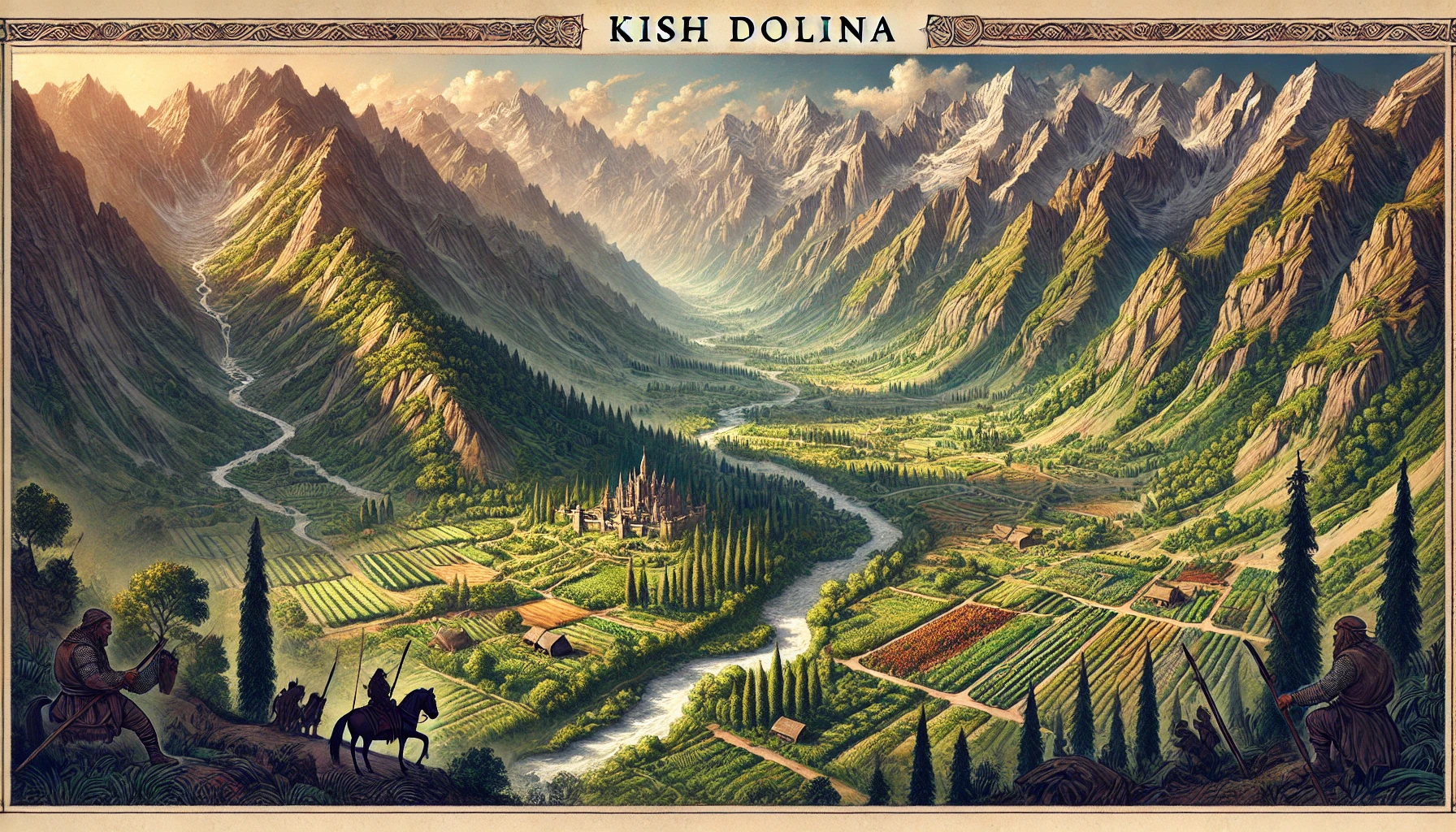[kish doh-lee-nah]
1. Overview
Kish Dolina, nestled within the imposing Kinzhal Mountain Range in Northwestern Siar’Morrin, offers a lush oasis amid stark surroundings. This fertile valley is the primary homeland for the orc populations of the region, presenting a serene environment that belies the underlying tensions. Despite its natural beauty, Kish Dolina is a land marked by division, where deep-seated rivalries and ancient grudges between two main orc factions shape its social and political landscape.

2. Geography
Surrounded by the rugged slopes of the Kinzhal Mountains, Kish Dolina stands as a verdant valley that contrasts sharply with the arid and unforgiving landscapes typical of Northwestern Siar’Morrin. The valley’s fertile soils and favorable climate make it an ideal location for agriculture and settlement, supporting a variety of flora and fauna that are rare in the region. However, its geographical isolation also makes it a natural fortress, often becoming the focal point of conflicts among its orc inhabitants.
3. History
Kish Dolina has a tumultuous history, primarily shaped by the conflict between its orc factions. One faction worships ancient dragons, drawing on their legendary power and wisdom, while the other looks to celestial deities for guidance. This theological divide has led to frequent skirmishes and power struggles. Historically, the valley has seen brief periods of unity under strong orc leaders who have attempted to expand southward, targeting strategic locations like Fort Logos. These invasions have largely failed, with the exception of a significant but temporary gain during the Age of Darkness, when regional defenses were compromised.
4. Political Structure
The governance of Kish Dolina is fragmented, dominated by the two major orc factions that vie for control over the valley. Each faction is led by its own chieftain and council, who govern according to their group’s beliefs and traditions. Occasionally, charismatic leaders emerge who temporarily unite these factions under a single banner, driven by ambitions of expansion and conquest. These periods of unity are often short-lived, dissolving back into rivalry once the external threat wanes or the leader’s influence fades.
5. Economy
Kish Dolina’s economy is predominantly agrarian, with the fertile valley supporting farming and livestock, unusual for orc communities. However, the constant state of conflict impacts economic stability, as resources are often diverted to support war efforts instead of community development. Trade within the valley is robust among the orcs, but their aggressive reputation and internal divisions limit their economic interactions with neighboring regions.
6. Culture and Society
In Kish Dolina, the orcish penchant for conflict is not merely a response to adversity but a fundamental aspect of their culture, deeply ingrained even amidst the fertile lands they inhabit. The valley, lush and inviting, has ironically become a stage for perpetual division, primarily driven by differing allegiances to either draconic deities or celestial beings. These divisions manifest not only in open conflict but also in various contests of strength and will, central to social interaction and status within orc communities.
The cultural life in Kish Dolina revolves around these displays of physical prowess and determination, with less emphasis on the more nuanced or intellectual pursuits found in other societies. Festivals and gatherings, while rich in energy and communal spirit, often escalate into competitive events, where individuals and factions showcase their strength and bravery. This focus on martial ability overshadows other aspects of culture, such as art, music, or literature, which remain underdeveloped or tethered to themes of war and conquest.
7. Military
The military capabilities of Kish Dolina are formidable, primarily due to the orc’s intrinsic warrior nature and the strategic importance of the valley. Each faction maintains its own armed forces, and the valley’s history is replete with internal conflicts and external invasions. The military structure is typically organized around the strongest and most capable warriors, with leadership often determined in battle.
8. Notable Locations
List and describe significant cities, landmarks, or mysterious places within the region. This can include capitals, cultural sites, and areas of particular danger or interest.
9. Significant Characters
Introduce key figures associated with the region, such as rulers, heroes, or villains. Include brief descriptions of their roles and impacts on the region.
10. Current Issues and Future Prospects
Kish Dolina continues to grapple with its internal divisions, which inhibit any long-term stability or growth. The ongoing conflict between the dragon and celestial worshippers shapes much of the valley’s political and social life. Looking ahead, the potential for another unifying leader or an external threat could once again change the dynamics within the valley, for better or worse.